BA3UK90O: Managing People and Systems Assessment 2: Induction Essay
VerifiedAdded on 2022/12/27
|8
|2176
|20
Essay
AI Summary
This essay critically evaluates the importance of employee induction in the modern workplace. It explores the concept of induction as a broader process than orientation, emphasizing its role in helping new employees understand their rights, duties, and responsibilities. The essay delves into relevant theories, including classical administration theory, modern management theory, and scientific management theory, to provide a comprehensive understanding of the topic. It also examines motivation theories and analyzes the benefits of induction programs, such as facilitating socialisation and improving employee retention. The essay concludes with recommendations for effective induction programs, including the use of a Learning Management System (LMS) and a structured approach covering various aspects of the company, from its history and policies to employee roles and responsibilities. This essay offers valuable insights into creating an effective employee onboarding experience.
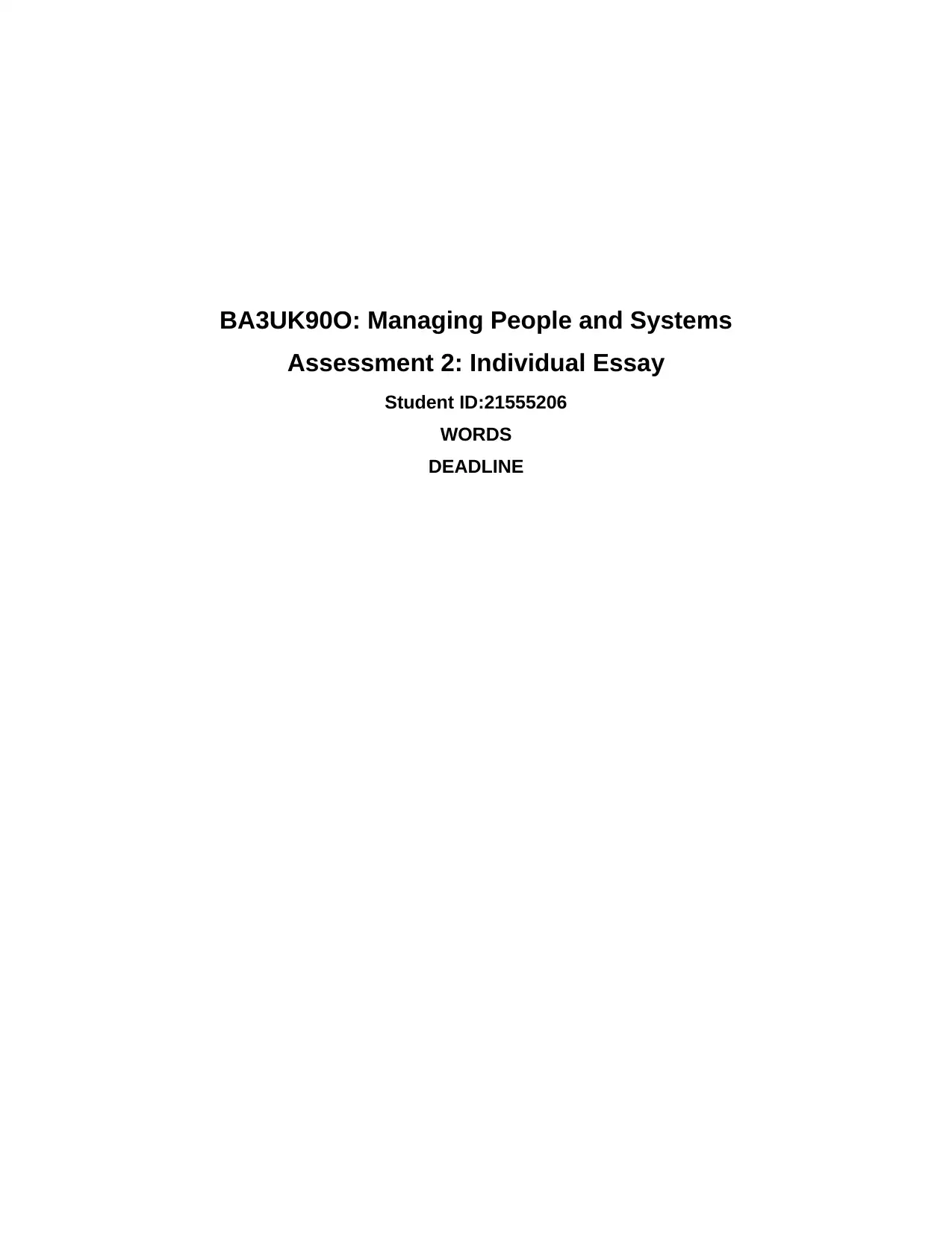
BA3UK90O: Managing People and Systems
Assessment 2: Individual Essay
Student ID:21555206
WORDS
DEADLINE
Assessment 2: Individual Essay
Student ID:21555206
WORDS
DEADLINE
Paraphrase This Document
Need a fresh take? Get an instant paraphrase of this document with our AI Paraphraser
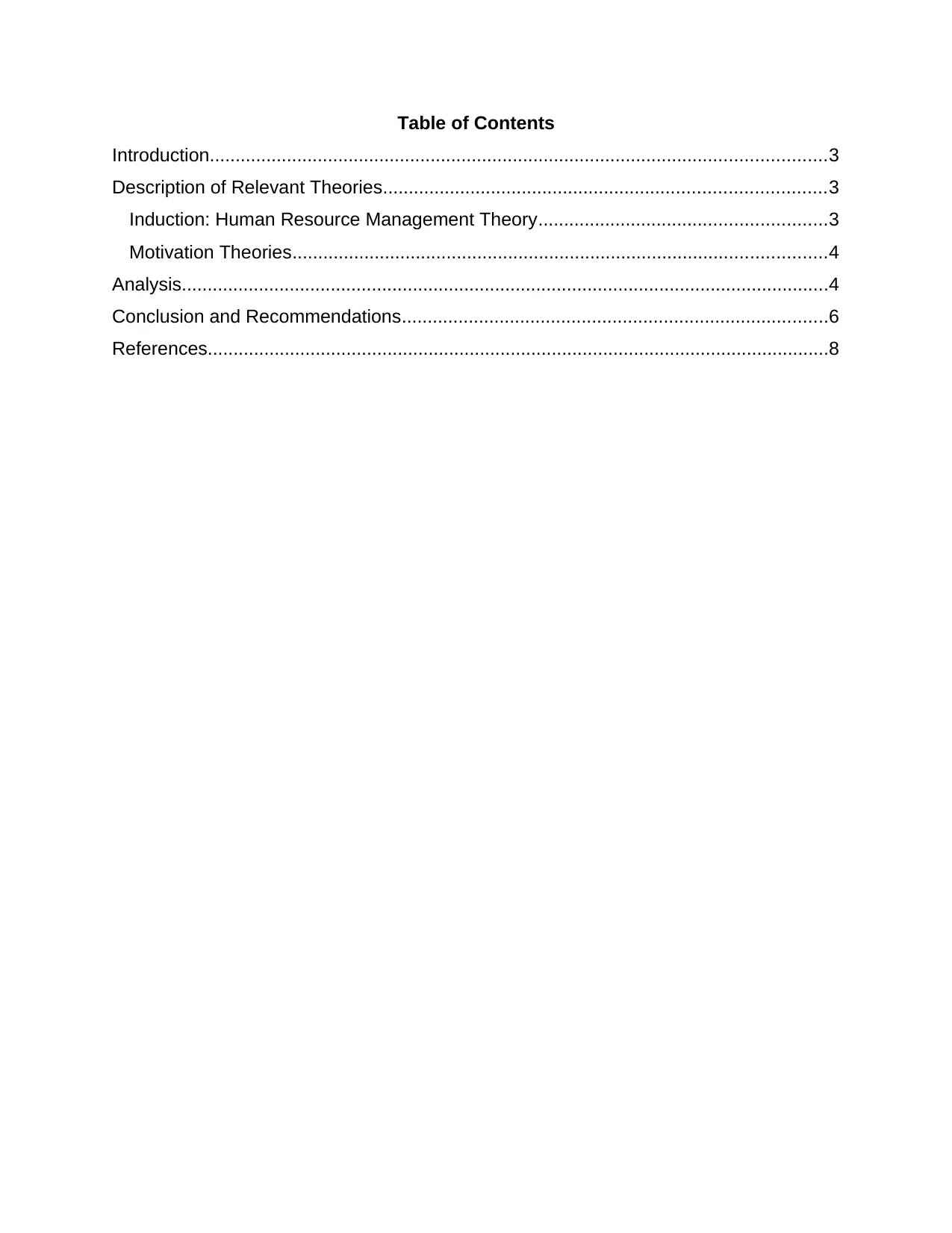
Table of Contents
Introduction........................................................................................................................3
Description of Relevant Theories......................................................................................3
Induction: Human Resource Management Theory........................................................3
Motivation Theories........................................................................................................4
Analysis..............................................................................................................................4
Conclusion and Recommendations...................................................................................6
References.........................................................................................................................8
Introduction........................................................................................................................3
Description of Relevant Theories......................................................................................3
Induction: Human Resource Management Theory........................................................3
Motivation Theories........................................................................................................4
Analysis..............................................................................................................................4
Conclusion and Recommendations...................................................................................6
References.........................................................................................................................8
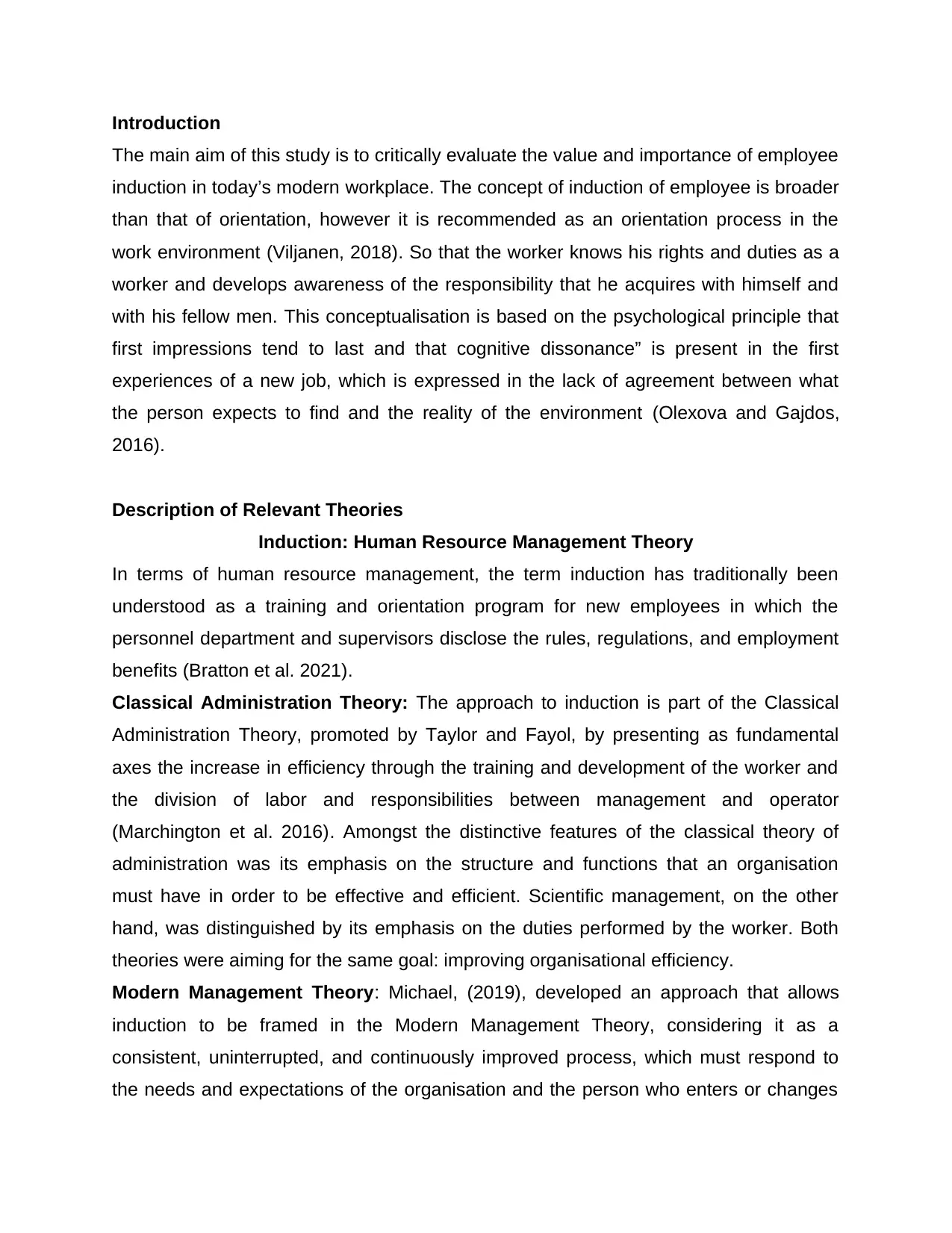
Introduction
The main aim of this study is to critically evaluate the value and importance of employee
induction in today’s modern workplace. The concept of induction of employee is broader
than that of orientation, however it is recommended as an orientation process in the
work environment (Viljanen, 2018). So that the worker knows his rights and duties as a
worker and develops awareness of the responsibility that he acquires with himself and
with his fellow men. This conceptualisation is based on the psychological principle that
first impressions tend to last and that cognitive dissonance” is present in the first
experiences of a new job, which is expressed in the lack of agreement between what
the person expects to find and the reality of the environment (Olexova and Gajdos,
2016).
Description of Relevant Theories
Induction: Human Resource Management Theory
In terms of human resource management, the term induction has traditionally been
understood as a training and orientation program for new employees in which the
personnel department and supervisors disclose the rules, regulations, and employment
benefits (Bratton et al. 2021).
Classical Administration Theory: The approach to induction is part of the Classical
Administration Theory, promoted by Taylor and Fayol, by presenting as fundamental
axes the increase in efficiency through the training and development of the worker and
the division of labor and responsibilities between management and operator
(Marchington et al. 2016). Amongst the distinctive features of the classical theory of
administration was its emphasis on the structure and functions that an organisation
must have in order to be effective and efficient. Scientific management, on the other
hand, was distinguished by its emphasis on the duties performed by the worker. Both
theories were aiming for the same goal: improving organisational efficiency.
Modern Management Theory: Michael, (2019), developed an approach that allows
induction to be framed in the Modern Management Theory, considering it as a
consistent, uninterrupted, and continuously improved process, which must respond to
the needs and expectations of the organisation and the person who enters or changes
The main aim of this study is to critically evaluate the value and importance of employee
induction in today’s modern workplace. The concept of induction of employee is broader
than that of orientation, however it is recommended as an orientation process in the
work environment (Viljanen, 2018). So that the worker knows his rights and duties as a
worker and develops awareness of the responsibility that he acquires with himself and
with his fellow men. This conceptualisation is based on the psychological principle that
first impressions tend to last and that cognitive dissonance” is present in the first
experiences of a new job, which is expressed in the lack of agreement between what
the person expects to find and the reality of the environment (Olexova and Gajdos,
2016).
Description of Relevant Theories
Induction: Human Resource Management Theory
In terms of human resource management, the term induction has traditionally been
understood as a training and orientation program for new employees in which the
personnel department and supervisors disclose the rules, regulations, and employment
benefits (Bratton et al. 2021).
Classical Administration Theory: The approach to induction is part of the Classical
Administration Theory, promoted by Taylor and Fayol, by presenting as fundamental
axes the increase in efficiency through the training and development of the worker and
the division of labor and responsibilities between management and operator
(Marchington et al. 2016). Amongst the distinctive features of the classical theory of
administration was its emphasis on the structure and functions that an organisation
must have in order to be effective and efficient. Scientific management, on the other
hand, was distinguished by its emphasis on the duties performed by the worker. Both
theories were aiming for the same goal: improving organisational efficiency.
Modern Management Theory: Michael, (2019), developed an approach that allows
induction to be framed in the Modern Management Theory, considering it as a
consistent, uninterrupted, and continuously improved process, which must respond to
the needs and expectations of the organisation and the person who enters or changes
⊘ This is a preview!⊘
Do you want full access?
Subscribe today to unlock all pages.

Trusted by 1+ million students worldwide
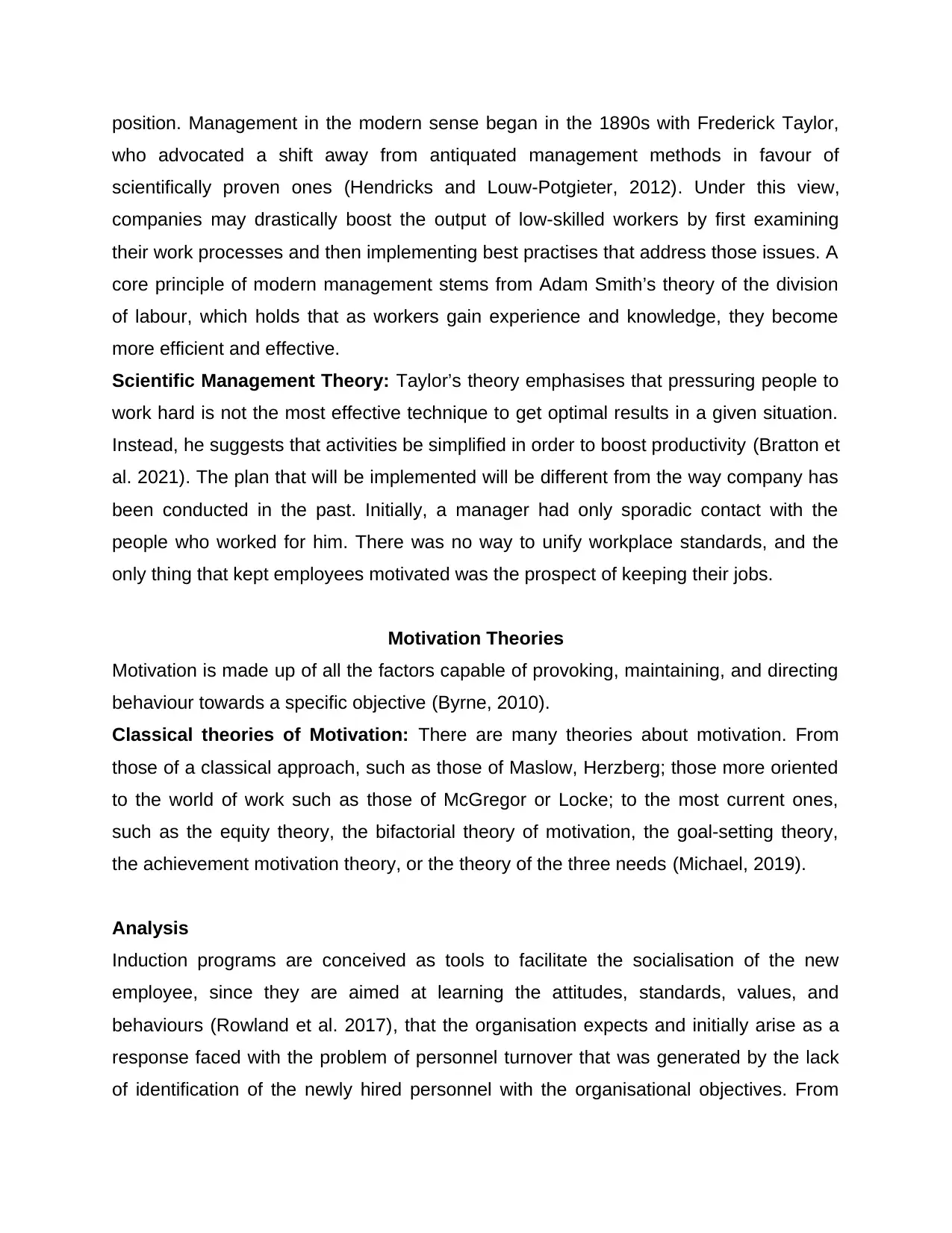
position. Management in the modern sense began in the 1890s with Frederick Taylor,
who advocated a shift away from antiquated management methods in favour of
scientifically proven ones (Hendricks and Louw-Potgieter, 2012). Under this view,
companies may drastically boost the output of low-skilled workers by first examining
their work processes and then implementing best practises that address those issues. A
core principle of modern management stems from Adam Smith’s theory of the division
of labour, which holds that as workers gain experience and knowledge, they become
more efficient and effective.
Scientific Management Theory: Taylor’s theory emphasises that pressuring people to
work hard is not the most effective technique to get optimal results in a given situation.
Instead, he suggests that activities be simplified in order to boost productivity (Bratton et
al. 2021). The plan that will be implemented will be different from the way company has
been conducted in the past. Initially, a manager had only sporadic contact with the
people who worked for him. There was no way to unify workplace standards, and the
only thing that kept employees motivated was the prospect of keeping their jobs.
Motivation Theories
Motivation is made up of all the factors capable of provoking, maintaining, and directing
behaviour towards a specific objective (Byrne, 2010).
Classical theories of Motivation: There are many theories about motivation. From
those of a classical approach, such as those of Maslow, Herzberg; those more oriented
to the world of work such as those of McGregor or Locke; to the most current ones,
such as the equity theory, the bifactorial theory of motivation, the goal-setting theory,
the achievement motivation theory, or the theory of the three needs (Michael, 2019).
Analysis
Induction programs are conceived as tools to facilitate the socialisation of the new
employee, since they are aimed at learning the attitudes, standards, values, and
behaviours (Rowland et al. 2017), that the organisation expects and initially arise as a
response faced with the problem of personnel turnover that was generated by the lack
of identification of the newly hired personnel with the organisational objectives. From
who advocated a shift away from antiquated management methods in favour of
scientifically proven ones (Hendricks and Louw-Potgieter, 2012). Under this view,
companies may drastically boost the output of low-skilled workers by first examining
their work processes and then implementing best practises that address those issues. A
core principle of modern management stems from Adam Smith’s theory of the division
of labour, which holds that as workers gain experience and knowledge, they become
more efficient and effective.
Scientific Management Theory: Taylor’s theory emphasises that pressuring people to
work hard is not the most effective technique to get optimal results in a given situation.
Instead, he suggests that activities be simplified in order to boost productivity (Bratton et
al. 2021). The plan that will be implemented will be different from the way company has
been conducted in the past. Initially, a manager had only sporadic contact with the
people who worked for him. There was no way to unify workplace standards, and the
only thing that kept employees motivated was the prospect of keeping their jobs.
Motivation Theories
Motivation is made up of all the factors capable of provoking, maintaining, and directing
behaviour towards a specific objective (Byrne, 2010).
Classical theories of Motivation: There are many theories about motivation. From
those of a classical approach, such as those of Maslow, Herzberg; those more oriented
to the world of work such as those of McGregor or Locke; to the most current ones,
such as the equity theory, the bifactorial theory of motivation, the goal-setting theory,
the achievement motivation theory, or the theory of the three needs (Michael, 2019).
Analysis
Induction programs are conceived as tools to facilitate the socialisation of the new
employee, since they are aimed at learning the attitudes, standards, values, and
behaviours (Rowland et al. 2017), that the organisation expects and initially arise as a
response faced with the problem of personnel turnover that was generated by the lack
of identification of the newly hired personnel with the organisational objectives. From
Paraphrase This Document
Need a fresh take? Get an instant paraphrase of this document with our AI Paraphraser
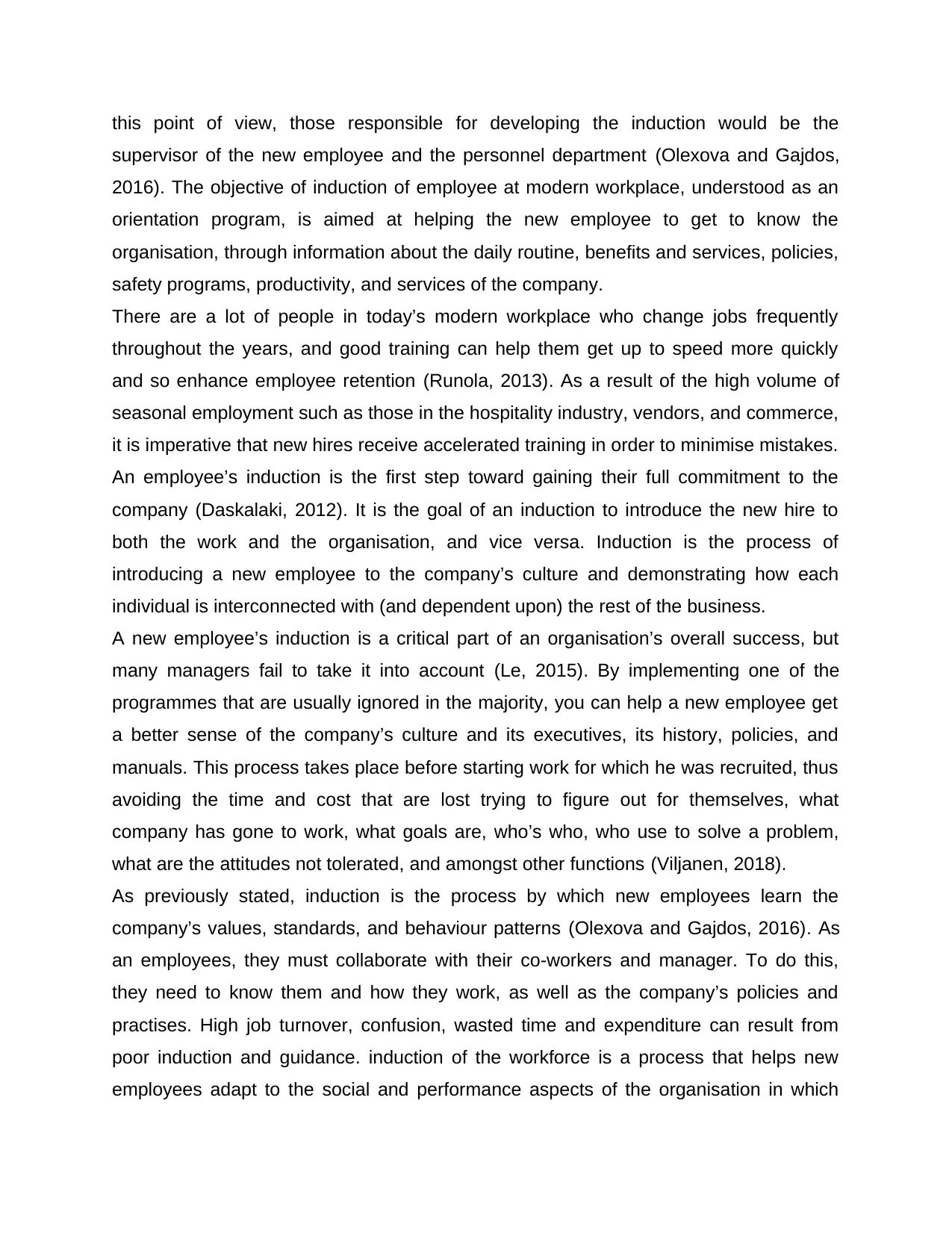
this point of view, those responsible for developing the induction would be the
supervisor of the new employee and the personnel department (Olexova and Gajdos,
2016). The objective of induction of employee at modern workplace, understood as an
orientation program, is aimed at helping the new employee to get to know the
organisation, through information about the daily routine, benefits and services, policies,
safety programs, productivity, and services of the company.
There are a lot of people in today’s modern workplace who change jobs frequently
throughout the years, and good training can help them get up to speed more quickly
and so enhance employee retention (Runola, 2013). As a result of the high volume of
seasonal employment such as those in the hospitality industry, vendors, and commerce,
it is imperative that new hires receive accelerated training in order to minimise mistakes.
An employee’s induction is the first step toward gaining their full commitment to the
company (Daskalaki, 2012). It is the goal of an induction to introduce the new hire to
both the work and the organisation, and vice versa. Induction is the process of
introducing a new employee to the company’s culture and demonstrating how each
individual is interconnected with (and dependent upon) the rest of the business.
A new employee’s induction is a critical part of an organisation’s overall success, but
many managers fail to take it into account (Le, 2015). By implementing one of the
programmes that are usually ignored in the majority, you can help a new employee get
a better sense of the company’s culture and its executives, its history, policies, and
manuals. This process takes place before starting work for which he was recruited, thus
avoiding the time and cost that are lost trying to figure out for themselves, what
company has gone to work, what goals are, who’s who, who use to solve a problem,
what are the attitudes not tolerated, and amongst other functions (Viljanen, 2018).
As previously stated, induction is the process by which new employees learn the
company’s values, standards, and behaviour patterns (Olexova and Gajdos, 2016). As
an employees, they must collaborate with their co-workers and manager. To do this,
they need to know them and how they work, as well as the company’s policies and
practises. High job turnover, confusion, wasted time and expenditure can result from
poor induction and guidance. induction of the workforce is a process that helps new
employees adapt to the social and performance aspects of the organisation in which
supervisor of the new employee and the personnel department (Olexova and Gajdos,
2016). The objective of induction of employee at modern workplace, understood as an
orientation program, is aimed at helping the new employee to get to know the
organisation, through information about the daily routine, benefits and services, policies,
safety programs, productivity, and services of the company.
There are a lot of people in today’s modern workplace who change jobs frequently
throughout the years, and good training can help them get up to speed more quickly
and so enhance employee retention (Runola, 2013). As a result of the high volume of
seasonal employment such as those in the hospitality industry, vendors, and commerce,
it is imperative that new hires receive accelerated training in order to minimise mistakes.
An employee’s induction is the first step toward gaining their full commitment to the
company (Daskalaki, 2012). It is the goal of an induction to introduce the new hire to
both the work and the organisation, and vice versa. Induction is the process of
introducing a new employee to the company’s culture and demonstrating how each
individual is interconnected with (and dependent upon) the rest of the business.
A new employee’s induction is a critical part of an organisation’s overall success, but
many managers fail to take it into account (Le, 2015). By implementing one of the
programmes that are usually ignored in the majority, you can help a new employee get
a better sense of the company’s culture and its executives, its history, policies, and
manuals. This process takes place before starting work for which he was recruited, thus
avoiding the time and cost that are lost trying to figure out for themselves, what
company has gone to work, what goals are, who’s who, who use to solve a problem,
what are the attitudes not tolerated, and amongst other functions (Viljanen, 2018).
As previously stated, induction is the process by which new employees learn the
company’s values, standards, and behaviour patterns (Olexova and Gajdos, 2016). As
an employees, they must collaborate with their co-workers and manager. To do this,
they need to know them and how they work, as well as the company’s policies and
practises. High job turnover, confusion, wasted time and expenditure can result from
poor induction and guidance. induction of the workforce is a process that helps new
employees adapt to the social and performance aspects of the organisation in which
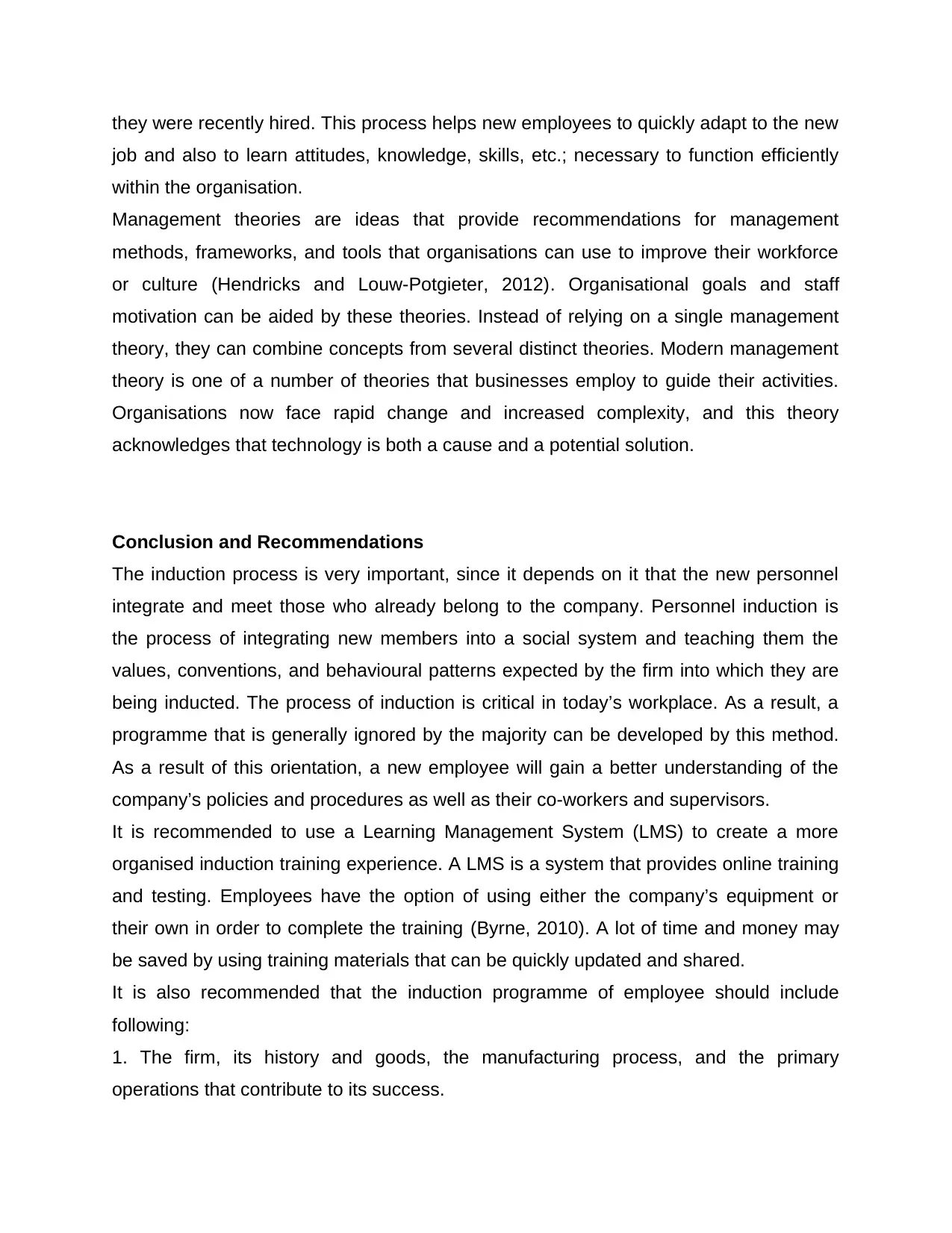
they were recently hired. This process helps new employees to quickly adapt to the new
job and also to learn attitudes, knowledge, skills, etc.; necessary to function efficiently
within the organisation.
Management theories are ideas that provide recommendations for management
methods, frameworks, and tools that organisations can use to improve their workforce
or culture (Hendricks and Louw-Potgieter, 2012). Organisational goals and staff
motivation can be aided by these theories. Instead of relying on a single management
theory, they can combine concepts from several distinct theories. Modern management
theory is one of a number of theories that businesses employ to guide their activities.
Organisations now face rapid change and increased complexity, and this theory
acknowledges that technology is both a cause and a potential solution.
Conclusion and Recommendations
The induction process is very important, since it depends on it that the new personnel
integrate and meet those who already belong to the company. Personnel induction is
the process of integrating new members into a social system and teaching them the
values, conventions, and behavioural patterns expected by the firm into which they are
being inducted. The process of induction is critical in today’s workplace. As a result, a
programme that is generally ignored by the majority can be developed by this method.
As a result of this orientation, a new employee will gain a better understanding of the
company’s policies and procedures as well as their co-workers and supervisors.
It is recommended to use a Learning Management System (LMS) to create a more
organised induction training experience. A LMS is a system that provides online training
and testing. Employees have the option of using either the company’s equipment or
their own in order to complete the training (Byrne, 2010). A lot of time and money may
be saved by using training materials that can be quickly updated and shared.
It is also recommended that the induction programme of employee should include
following:
1. The firm, its history and goods, the manufacturing process, and the primary
operations that contribute to its success.
job and also to learn attitudes, knowledge, skills, etc.; necessary to function efficiently
within the organisation.
Management theories are ideas that provide recommendations for management
methods, frameworks, and tools that organisations can use to improve their workforce
or culture (Hendricks and Louw-Potgieter, 2012). Organisational goals and staff
motivation can be aided by these theories. Instead of relying on a single management
theory, they can combine concepts from several distinct theories. Modern management
theory is one of a number of theories that businesses employ to guide their activities.
Organisations now face rapid change and increased complexity, and this theory
acknowledges that technology is both a cause and a potential solution.
Conclusion and Recommendations
The induction process is very important, since it depends on it that the new personnel
integrate and meet those who already belong to the company. Personnel induction is
the process of integrating new members into a social system and teaching them the
values, conventions, and behavioural patterns expected by the firm into which they are
being inducted. The process of induction is critical in today’s workplace. As a result, a
programme that is generally ignored by the majority can be developed by this method.
As a result of this orientation, a new employee will gain a better understanding of the
company’s policies and procedures as well as their co-workers and supervisors.
It is recommended to use a Learning Management System (LMS) to create a more
organised induction training experience. A LMS is a system that provides online training
and testing. Employees have the option of using either the company’s equipment or
their own in order to complete the training (Byrne, 2010). A lot of time and money may
be saved by using training materials that can be quickly updated and shared.
It is also recommended that the induction programme of employee should include
following:
1. The firm, its history and goods, the manufacturing process, and the primary
operations that contribute to its success.
⊘ This is a preview!⊘
Do you want full access?
Subscribe today to unlock all pages.

Trusted by 1+ million students worldwide
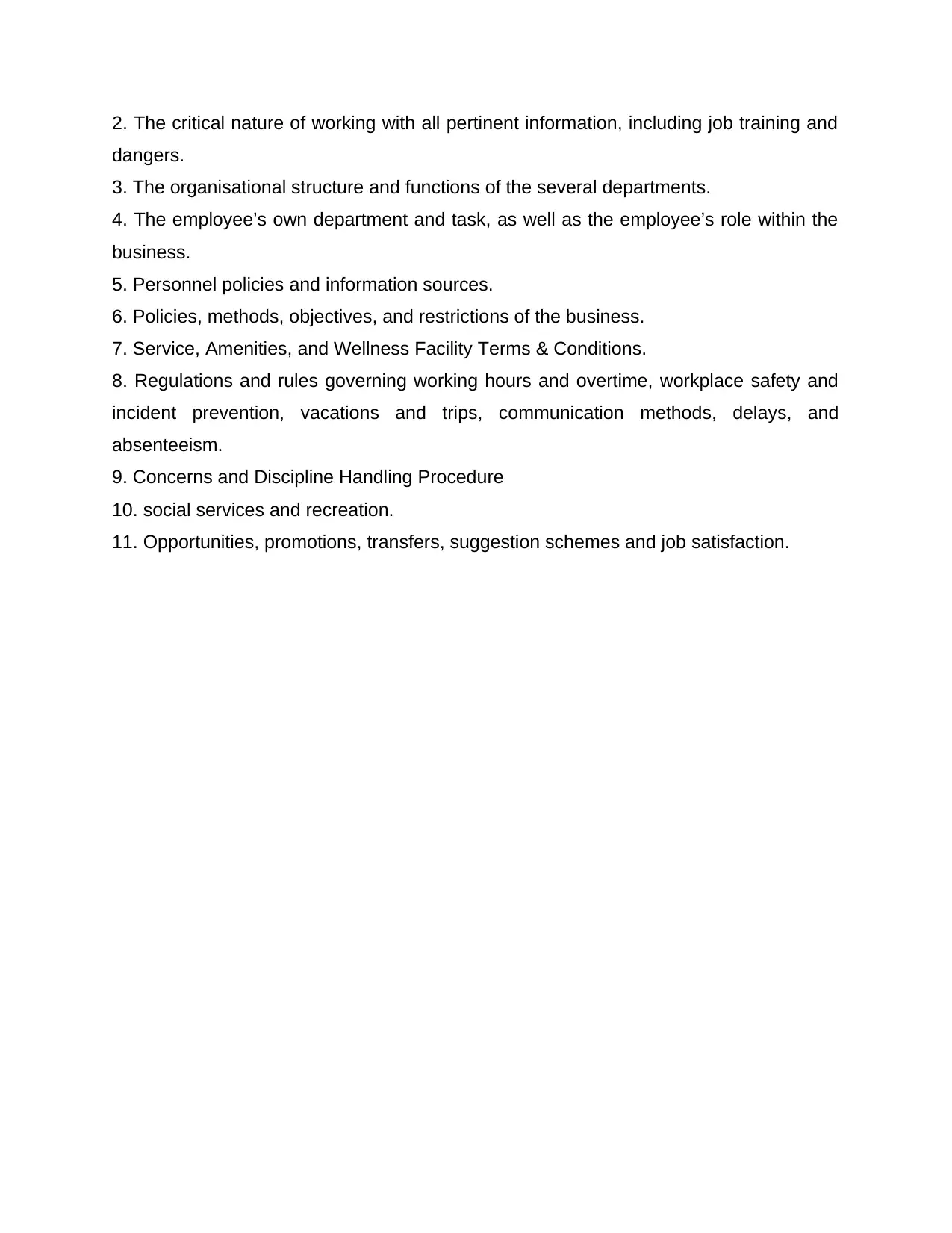
2. The critical nature of working with all pertinent information, including job training and
dangers.
3. The organisational structure and functions of the several departments.
4. The employee’s own department and task, as well as the employee’s role within the
business.
5. Personnel policies and information sources.
6. Policies, methods, objectives, and restrictions of the business.
7. Service, Amenities, and Wellness Facility Terms & Conditions.
8. Regulations and rules governing working hours and overtime, workplace safety and
incident prevention, vacations and trips, communication methods, delays, and
absenteeism.
9. Concerns and Discipline Handling Procedure
10. social services and recreation.
11. Opportunities, promotions, transfers, suggestion schemes and job satisfaction.
dangers.
3. The organisational structure and functions of the several departments.
4. The employee’s own department and task, as well as the employee’s role within the
business.
5. Personnel policies and information sources.
6. Policies, methods, objectives, and restrictions of the business.
7. Service, Amenities, and Wellness Facility Terms & Conditions.
8. Regulations and rules governing working hours and overtime, workplace safety and
incident prevention, vacations and trips, communication methods, delays, and
absenteeism.
9. Concerns and Discipline Handling Procedure
10. social services and recreation.
11. Opportunities, promotions, transfers, suggestion schemes and job satisfaction.
Paraphrase This Document
Need a fresh take? Get an instant paraphrase of this document with our AI Paraphraser
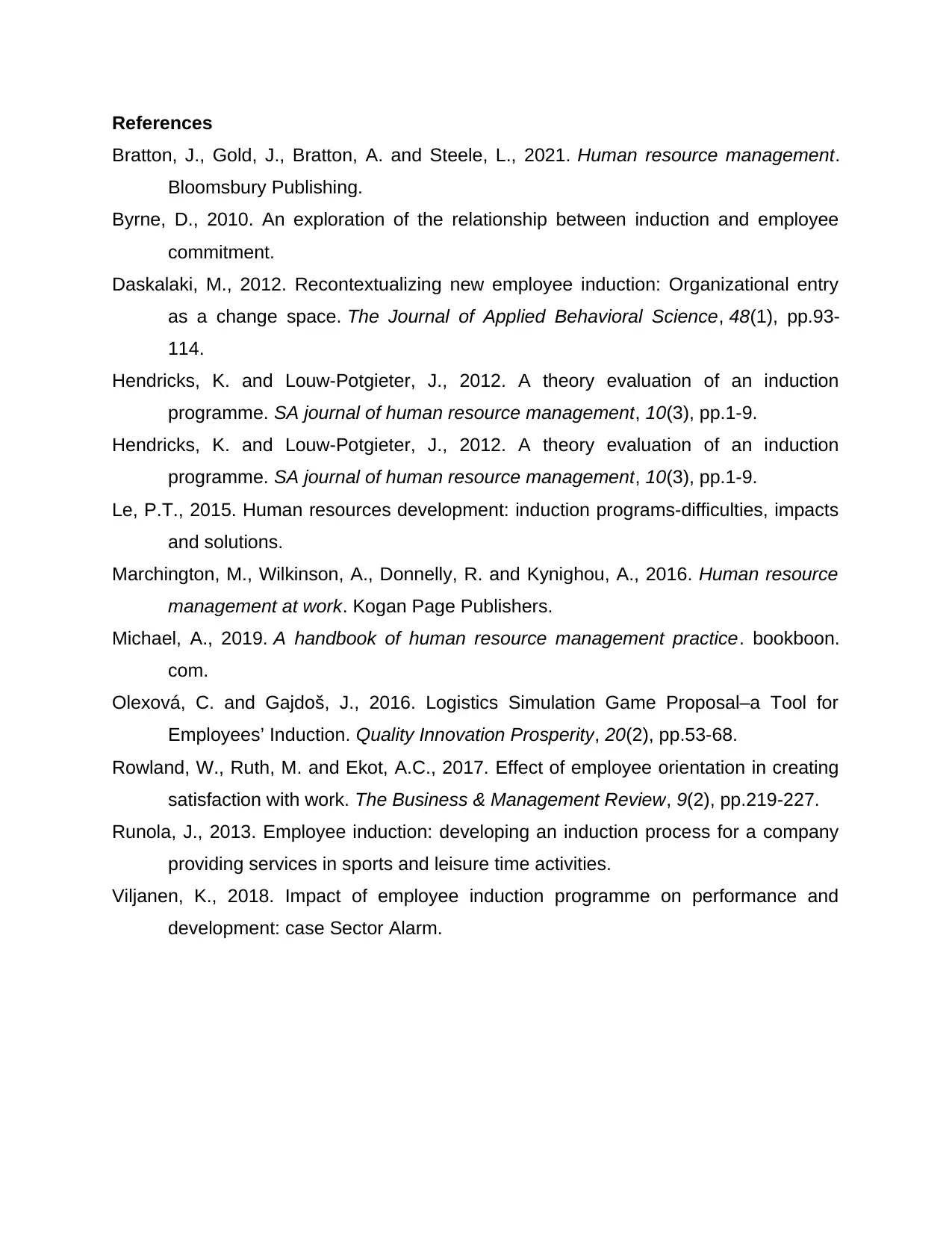
References
Bratton, J., Gold, J., Bratton, A. and Steele, L., 2021. Human resource management.
Bloomsbury Publishing.
Byrne, D., 2010. An exploration of the relationship between induction and employee
commitment.
Daskalaki, M., 2012. Recontextualizing new employee induction: Organizational entry
as a change space. The Journal of Applied Behavioral Science, 48(1), pp.93-
114.
Hendricks, K. and Louw-Potgieter, J., 2012. A theory evaluation of an induction
programme. SA journal of human resource management, 10(3), pp.1-9.
Hendricks, K. and Louw-Potgieter, J., 2012. A theory evaluation of an induction
programme. SA journal of human resource management, 10(3), pp.1-9.
Le, P.T., 2015. Human resources development: induction programs-difficulties, impacts
and solutions.
Marchington, M., Wilkinson, A., Donnelly, R. and Kynighou, A., 2016. Human resource
management at work. Kogan Page Publishers.
Michael, A., 2019. A handbook of human resource management practice. bookboon.
com.
Olexová, C. and Gajdoš, J., 2016. Logistics Simulation Game Proposal–a Tool for
Employees’ Induction. Quality Innovation Prosperity, 20(2), pp.53-68.
Rowland, W., Ruth, M. and Ekot, A.C., 2017. Effect of employee orientation in creating
satisfaction with work. The Business & Management Review, 9(2), pp.219-227.
Runola, J., 2013. Employee induction: developing an induction process for a company
providing services in sports and leisure time activities.
Viljanen, K., 2018. Impact of employee induction programme on performance and
development: case Sector Alarm.
Bratton, J., Gold, J., Bratton, A. and Steele, L., 2021. Human resource management.
Bloomsbury Publishing.
Byrne, D., 2010. An exploration of the relationship between induction and employee
commitment.
Daskalaki, M., 2012. Recontextualizing new employee induction: Organizational entry
as a change space. The Journal of Applied Behavioral Science, 48(1), pp.93-
114.
Hendricks, K. and Louw-Potgieter, J., 2012. A theory evaluation of an induction
programme. SA journal of human resource management, 10(3), pp.1-9.
Hendricks, K. and Louw-Potgieter, J., 2012. A theory evaluation of an induction
programme. SA journal of human resource management, 10(3), pp.1-9.
Le, P.T., 2015. Human resources development: induction programs-difficulties, impacts
and solutions.
Marchington, M., Wilkinson, A., Donnelly, R. and Kynighou, A., 2016. Human resource
management at work. Kogan Page Publishers.
Michael, A., 2019. A handbook of human resource management practice. bookboon.
com.
Olexová, C. and Gajdoš, J., 2016. Logistics Simulation Game Proposal–a Tool for
Employees’ Induction. Quality Innovation Prosperity, 20(2), pp.53-68.
Rowland, W., Ruth, M. and Ekot, A.C., 2017. Effect of employee orientation in creating
satisfaction with work. The Business & Management Review, 9(2), pp.219-227.
Runola, J., 2013. Employee induction: developing an induction process for a company
providing services in sports and leisure time activities.
Viljanen, K., 2018. Impact of employee induction programme on performance and
development: case Sector Alarm.
1 out of 8
Related Documents
Your All-in-One AI-Powered Toolkit for Academic Success.
+13062052269
info@desklib.com
Available 24*7 on WhatsApp / Email
![[object Object]](/_next/static/media/star-bottom.7253800d.svg)
Unlock your academic potential
Copyright © 2020–2025 A2Z Services. All Rights Reserved. Developed and managed by ZUCOL.





